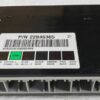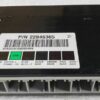Restore Full Function to Your GM Truck or SUV
Are you battling bizarre and frustrating electrical issues in your truck or SUV? Flickering lights, malfunctioning power windows, a security system that acts on its own, or warning chimes that won’t quit are all classic signs of a failing Body Control Module (BCM). Don’t let these electrical gremlins compromise the reliability you depend on. This pre-programmed BCM is the definitive, hassle-free solution to get your vehicle back to 100% operational condition, restoring your confidence on the road and at the job site.
Common Symptoms & Your Solution
A faulty BCM can feel like your vehicle has a mind of its own. It’s the central command center for all body-related electronics, and when it fails, the symptoms can be widespread and confusing. If you’re experiencing any of the following, this module is the fix you need:
- Intermittent or non-working power windows, door locks, or interior lights.
- Erratic instrument cluster behavior or warning lights that stay on.
- Climate control system not responding correctly.
- Remote keyless entry (RKE) failure.
- Security system faults or random alarm activation.
- Communication issues with other vehicle modules, often flagged by DTCs starting with ‘U’.
Instead of a costly trip to the dealership for diagnostics and programming, we handle the complex part for you. Simply provide your vehicle’s VIN during checkout, and we will flash this 22846365 BCM with the latest GM software specific to your exact build. It arrives at your door ready for a straightforward installation.
Features & Benefits
- ✔ VIN-Programmed for Your Vehicle: No need for expensive dealer tools or software. This module is flashed with your vehicle’s specific configuration for a true plug-and-drive repair.
- ✔ Save Time and Money: By bypassing the dealership’s programming service, you save hundreds of dollars and get your truck back on the road faster.
- ✔ Loaded with Latest GM Updates: We ensure your module has the newest, most stable software from General Motors, addressing potential bugs from the original programming.
- ✔ Direct-Fit Replacement: Guaranteed to fit and function correctly for all models listed, restoring all factory operations controlled by the BCM.
- ✔ No Core Charge: Keep your old part. There’s no need to worry about the cost or hassle of sending a core back to us.
- ✔ Peace of Mind Included: This unit is backed by our one-year replacement warranty.
Expert Insight: The Technician’s Edge
As a technician, I’ve seen firsthand the frustration of dealing with module failures. In the past, replacing a BCM meant the vehicle was down and out until it could be towed to a dealer. The vehicle was inoperable, the customer was without their truck, and the repair bill would be inflated by programming fees. This pre-programmed 22846365 BCM changes the game. It empowers knowledgeable DIYers and independent shops to complete the repair efficiently in their own bay or driveway. It’s not just a part; it’s a complete solution that puts control back in your hands.
Installation & Post-Install Notes
The BCM is typically located under the driver’s side of the dashboard, near the steering column. While installation is a plug-in process, some vehicles may require a simple relearn procedure after the new module is installed. Most commonly, this involves syncing the airbag system (SDM) or recalibrating the brake pedal position sensor. These procedures can often be performed with a high-quality bidirectional scan tool. Please refer to your vehicle’s service manual or consult with a qualified technician for specific instructions.
Frequently Asked Questions
What exactly does the BCM do?
The Body Control Module is a computer that acts as the central hub for your vehicle’s body electronics. It manages functions like power windows, door locks, interior and exterior lighting, the security system, and the instrument cluster, ensuring they all work together seamlessly.
Why do you need my VIN number?
Your Vehicle Identification Number (VIN) allows us to access the exact factory build sheet for your truck or SUV. We use this data to program the BCM with the correct software and settings for all the specific options your vehicle was built with, ensuring perfect compatibility.
My old BCM has a different part number. Will this still work?
Yes. GM often updates part numbers over time. This 22846365 BCM is the correct service replacement for all part numbers listed in the description, including 22737275 and 22846364. As long as your vehicle is listed, this module will work perfectly.
Are any other procedures required after installation?
In some cases, yes. You may need to perform a ‘Setup SDM Primary Key in BCM’ procedure if the airbag light comes on, or a ‘Brake Pedal Position Relearn’. These are simple procedures for a shop with a professional scan tool and ensure all related systems communicate correctly with the new BCM.
Is this a new or used part?
This is a high-quality, tested, and verified used component that has been expertly programmed with the latest software for your vehicle, offering a reliable and cost-effective alternative to a new dealer part.


